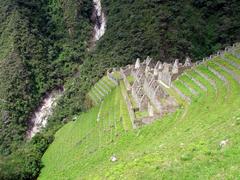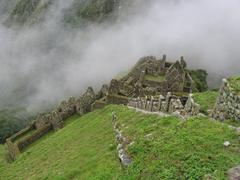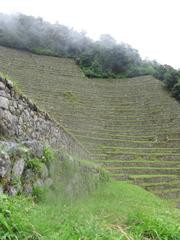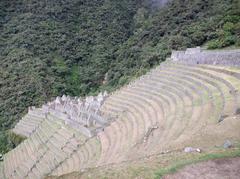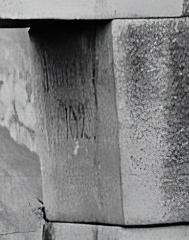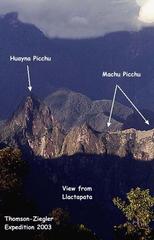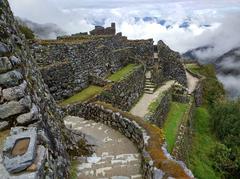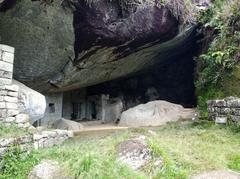
Wiñay Wayna Visiting Hours, Tickets, and Travel Guide near Machu Picchu, Peru
Date: 14/06/2025
Introduction to Wiñay Wayna: An Inca Jewel Near Machu Picchu
Wiñay Wayna, whose name means “Forever Young” in Quechua, is an extraordinary Inca archaeological site perched along the famous Inca Trail, just a few kilometers southwest of Machu Picchu. Seamlessly integrated into the misty cloud forests of the Andes at about 2,700 meters above sea level, Wiñay Wayna is a testament to the Inca Empire’s architectural ingenuity, agricultural expertise, and spiritual vision. Constructed in the 15th century during Emperor Pachacutec’s reign, the site was relatively unknown until the mid-20th century, offering today’s travelers a rare opportunity to experience a place of both historical importance and serene beauty (Orange Nation Peru; Stanford Inca Project).
Recognized for its harmonious blend of stonework, terracing, ritual baths, and residential compounds, Wiñay Wayna served as a vital waypoint for pilgrims en route to Machu Picchu. It functioned as an agricultural hub, ceremonial center, and checkpoint on the sacred Inca pilgrimage. Today, it continues to captivate historians, trekkers, and cultural explorers with its enduring vitality and spiritual ambiance. This comprehensive guide offers everything you need for your visit, from practical details on tickets and visiting hours to a deeper look at its architecture, ecological context, and cultural significance.
For official visit regulations, permits, and updates, see the Machu Picchu government website, Orange Nation Peru, and the Stanford Inca Project.
Table of Contents
- Introduction to Wiñay Wayna
- Historical Background and Discovery
- Architectural Highlights and Layout
- Purpose and Functionality
- Spiritual and Ecological Context
- Visiting Wiñay Wayna: Practical Information
- Travel Tips and Nearby Attractions
- Frequently Asked Questions (FAQ)
- Summary and Recommendations
- References
Historical Background and Discovery
Wiñay Wayna’s origins trace back to the 15th century, aligning with the expansion of the Inca Empire under Pachacutec (Auri Peru). Its name also refers to a native orchid abundant in the region, symbolizing the site’s vitality and the Inca belief in eternal renewal. While Machu Picchu was reintroduced to the world in 1911, Wiñay Wayna remained hidden until the early 1940s, when it was documented by scientific expeditions and later named by archaeologist Julio C. Tello (Stanford Inca Project).
Architectural Highlights and Layout
Wiñay Wayna exemplifies classic Inca urban planning and construction, blending seamlessly with the steep Andean landscape. The site consists of:
- Upper and Lower Residential Sectors: Two clusters of finely built stone houses, connected by a dramatic stone staircase and a series of ritual water fountains, believed to have been used for ceremonial purification.
- Extensive Agricultural Terraces: Dozens of curved terraces stabilized the slopes and provided arable land for crops like corn and coca, demonstrating the Incas’ mastery of high-altitude farming (Auri Peru).
- Temple of the Seven Windows: A ceremonial structure with seven trapezoidal windows, possibly dedicated to the Rainbow God.
- Qolqas (Storehouses): Storage buildings essential for food supplies on the Inca Trail and at Machu Picchu.
- Ceremonial Baths and Irrigation Channels: Ingeniously designed fountains and aqueducts for ritual and agricultural use, still functioning today.
The site’s design reflects Andean cosmology, with the upper (hanan) and lower (hurin) sectors symbolizing duality and balance in Inca culture (Journey Machu Picchu).
Purpose and Functionality
Agricultural and Administrative Center
The terracing and storehouses suggest Wiñay Wayna’s importance in food production and distribution for Machu Picchu and neighboring communities. Its strategic location on the Inca Trail made it a logistical node for the movement of people and goods (Orange Nation Peru).
Ceremonial and Spiritual Role
The site’s ritual fountains and temples indicate a function as a purification and transition point for pilgrims nearing Machu Picchu. Spiritual activities included cleansing rituals, fertility rites, and offerings to deities such as Inti (the Sun God) and Pachamama (Mother Earth).
Rest Stop and Checkpoint
As the final major stop before Machu Picchu, Wiñay Wayna served as a checkpoint and resting place, with views over the Urubamba River valley for surveillance and defense (Auri Peru).
Spiritual and Ecological Context
Spiritual Significance:
Wiñay Wayna’s design and location are imbued with spiritual meaning. The Incas revered mountains (apus), water sources, and the duality of the upper and lower worlds. Ritual baths and ceremonial plazas were integral for spiritual purification and offerings, emphasizing the site’s role in preparing travelers for the sacred approach to Machu Picchu (Short Inca Trail Machu Picchu).
Ecological Setting:
Wiñay Wayna is enveloped by cloud forest, home to over 2,000 plant species, including 179 species of orchids, and a remarkable array of birds and mammals such as the Andean cock-of-the-rock and the spectacled bear (Lyonia Journal; Machu Picchu Wayna). Conservation efforts are ongoing to protect this biodiversity from the impacts of tourism and environmental change.
Visiting Wiñay Wayna: Practical Information
Access and Permits
- Inca Trail Permits: Required for all visitors; must be booked months in advance through authorized operators due to strict daily quotas (Machu Picchu government website; Salkantay Trek).
- Included with Permit: Entry to Wiñay Wayna is bundled with Inca Trail and Machu Picchu permits.
- Alternative Access: The site is not accessible by road; only by foot via the Inca Trail or short Inca Trail treks.
Visiting Hours
- Typical Hours: Wiñay Wayna is open during the Inca Trail trekking season, generally from 5:30 AM to 5:30 PM (some sources note 6:00 AM–5:30 PM or 8:00 AM–8:00 PM; always check current regulations before visiting).
Tickets and Pricing
- Permit Costs: Inca Trail permits (including Wiñay Wayna) generally range from $500 to $700 USD depending on the season and tour package.
- Booking: Only available through licensed tour operators; separate entry tickets to Wiñay Wayna are not sold.
Travel Tips and Nearby Attractions
- Best Time to Visit: Dry season (May–September) offers better weather and safer trail conditions.
- Acclimatization: Spend several days in Cusco or the Sacred Valley to adjust to the altitude before trekking.
- What to Bring: Sturdy hiking boots, layered clothing, rain gear, sun protection, insect repellent, 1.5–2 liters of water per day, snacks, and a camera.
- Facilities: Basic campsites near Wiñay Wayna have toilets but no showers; bring all essentials and carry out all waste.
- Guided Tours: All Inca Trail treks include licensed guides who provide cultural, historical, and environmental interpretation.
- Nearby Highlights: After Wiñay Wayna, trekkers reach Inti Punku (Sun Gate) with panoramic views of Machu Picchu. Additional Cusco region sites include Ollantaytambo, Pisac, and the Sacred Valley.
Frequently Asked Questions (FAQ)
Q: What are the visiting hours at Wiñay Wayna?
A: Visiting hours typically range from early morning (5:30–6:00 AM) to late afternoon (5:30 PM), though some permits indicate access as late as 8:00 PM. Always confirm with your tour operator.
Q: Do I need a separate ticket to visit Wiñay Wayna?
A: No, entry is included with your Inca Trail permit.
Q: How difficult is the hike to Wiñay Wayna?
A: The trek is moderate to challenging, involving steep staircases and high altitude.
Q: Are guided tours available?
A: Yes, guided tours are included in all Inca Trail packages.
Q: Can I visit Wiñay Wayna without hiking the Inca Trail?
A: Access is primarily through the Inca Trail; alternative independent access is rarely permitted and subject to conservation regulations.
Q: Is Wiñay Wayna accessible for visitors with mobility impairments?
A: Due to steep and uneven terrain, the site is not suitable for visitors with limited mobility.
Summary and Recommendations
Wiñay Wayna offers a profound encounter with the Inca civilization’s architectural, agricultural, and spiritual achievements. Secure your permits early, prepare for the altitude and terrain, and respect site regulations to ensure a rewarding and responsible visit. Enhance your experience through guided tours, photography, and cultural reflection amidst the site’s breathtaking terraces and cloud forest setting.
For the latest regulations, permit availability, and expert tips, consult the Peru Ministry of Culture, UNESCO World Heritage Centre, and trusted travel platforms. Download the Audiala app for in-depth guides, itineraries, and exclusive content, and follow our social media for updates and inspiration.
References
- Orange Nation Peru - Wiñay Wayna
- Stanford Inca Project - Wiñay Wayna
- Salkantay Trek - Royal Short Inca Trail
- Short Inca Trail Machu Picchu
- Machu Travel Peru
- Peru Ministry of Culture
- UNESCO World Heritage Centre - Machu Picchu
- Lyonia Journal
- Journey Machu Picchu
- Machu Picchu Wayna - Birds
- Auri Peru
- Peru Grand Travel
- Explorers Passage
- Treks in Cusco
- History Hit
- Tourist Link
- Inca Trail Machu


